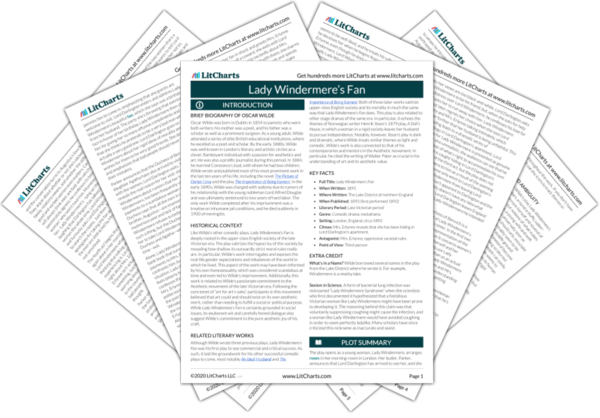Welcome to the LitCharts study guide on Oscar Wilde's Lady Windermere’s Fan. Created by the original team behind SparkNotes, LitCharts are the world's best literature guides.
Lady Windermere’s Fan: Introduction
Lady Windermere’s Fan: Plot Summary
Lady Windermere’s Fan: Detailed Summary & Analysis
Lady Windermere’s Fan: Themes
Lady Windermere’s Fan: Quotes
Lady Windermere’s Fan: Characters
Lady Windermere’s Fan: Symbols
Lady Windermere’s Fan: Literary Devices
Lady Windermere’s Fan: Theme Wheel
Brief Biography of Oscar Wilde

Historical Context of Lady Windermere’s Fan
Other Books Related to Lady Windermere’s Fan
- Full Title: Lady Windermere’s Fan
- When Written: 1891
- Where Written: The Lake District of northern England
- When Published: 1893 (first performed 1892)
- Literary Period: Late Victorian period
- Genre: Comedic drama; melodrama
- Setting: London, England, circa 1892
- Climax: Mrs. Erlynne reveals that she has been hiding in Lord Darlington’s apartment.
- Antagonist: Mrs. Erlynne; oppressive societal rules
- Point of View: Third-person
Extra Credit for Lady Windermere’s Fan
What’s in a Name? Wilde borrowed several names in the play from the Lake District where he wrote it. For example, Windermere is a nearby lake.
Sexism in Science. A form of bacterial lung infection was nicknamed “Lady Windermere Syndrome” when the scientists who first documented it hypothesized that a fastidious Victorian woman like Lady Windermere might have been prone to developing it. The reasoning behind this claim was that voluntarily suppressing coughing might cause the infection, and a woman like Lady Windermere would have avoided coughing in order to seem perfectly ladylike. Many scholars have since criticized this nickname as inaccurate and sexist.







